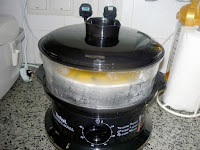Everybody loves steamed eggs especially if it is soft and
silky. It is not easy to get it perfect all the time especially me because I always
forget the timing i.e. when I put the mixture into the steamer or when to take
it out. I decided to use the electric steamer today because it has a timer. Unfortunately,
I did not hear the timer so the egg was left in the steamer too long and I ended
up with a lot of holes in the egg. Hopefully, better luck next time when I try the electric steamer again.
I like to buy pidan with the husks on because the yolks are
firm and not runny compared to those without the husks.
Ingredients
3 chicken eggs (room temperature)
1 pidan
1 hard boiled salted egg
This is how I peel the pidan.
Put the pidan into a small used plastic bag
Crack the pidan and peel off the shell in the bag.
This way there are no bits of husks or shell falling onto
the counter top or floor.
Cut the pidan and salted egg into small pieces.
Make a hole in the bottom of one egg.
Put the egg into the bowl with the other eggs
Use the egg shell to measure the amount of water to add
into the eggs.
The ratio is to use 1 ½ egg shell or 3 half egg shell of
water per egg.
Using the egg shell to measure the water is ideal because
no matter what size eggs you use the ratio will always be right.
Add a little salt and pepper into the egg mixture.
Lightly beat eggs.
Strain the egg mixture to get rid of bubbles to ensure a smooth and
silky texture.
Strain the egg
mixture a second time into a shallow heatproof dish.
See the bubbles left in the strainer?
Add the pidan and salted egg into the mixture.
Place the dish
onto the prepared steamer.
Cover and steam on low heat for 10 minutes.
Do not use high heat or the texture will be
coarse.
Alternatively, you can use an electric steamer.
Cover and steam for 10 minutes or until egg is set.
If you're not sure if the egg has set, shake the
dish a little and the egg should be jiggly but firm.
Make sure that water droplets on the lid do not drip onto the steamed
eggs when removing from the steamer.






























No comments:
Post a Comment